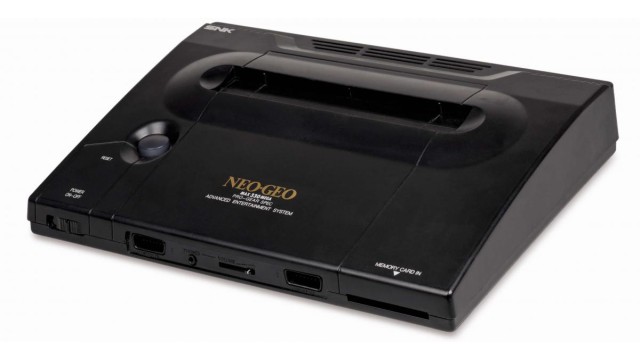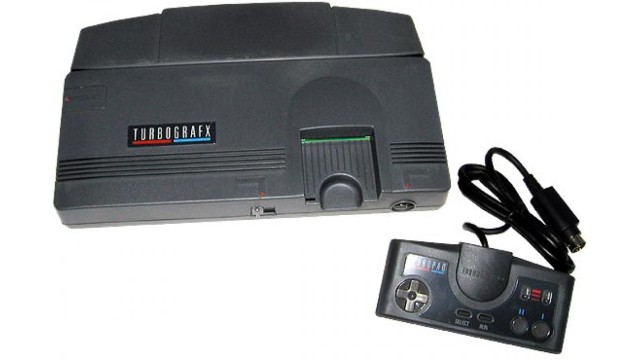
Neo-Geo
Launches: 1990
Discontinued: 1997
Life span: 7 years
Units sold: 1 000 000
Generation: 4th
 Neo-Geo technical specifications
Neo-Geo technical specifications
CPU: Motorola 68000 (16 bits)
Memory: 64 KB
 Neo-Geo video specifications
Neo-Geo video specifications
Neo-Geo graphics capabilities.
Neo-Geo video modes
| 320×224 | 4096 colors using a 65536 colors palette | NTSC |
| 320×256 | 4096 colors using a 65536 colors palette | PAL |
 Neo-Geo audio specifications
Neo-Geo audio specifications
Neo-Geo sound capabilities.
Audio chip: Yamaha YM2610
Audio mode: Stereo
 Controllers of Neo-Geo
Controllers of Neo-Geo
 Neo-Geo games support
Neo-Geo games support
Support: Cartridge
Neo-Geo games
Games library:
Neo-Geo story
The Neo Geo, developed by SNK Corporation, represents one of the most ambitious and unique entries in the history of video game consoles. Its creation, development, launch, and market reception offer a compelling story of innovation, premium gaming experiences, and niche success.
The creation of the Neo Geo began with SNK’s desire to replicate the high-quality arcade experiences at home. In the early 1990s, the arcade gaming industry was flourishing with titles that boasted impressive graphics and gameplay. SNK was known for its popular arcade games, such as "King of Fighters" and "Samurai Shodown," which showcased the company's prowess in creating engaging and visually stunning games. Recognizing the growing demand for superior home gaming experiences, SNK set out to design a console that could deliver the same level of quality and performance as their arcade machines.
SNK's vision for the Neo Geo was ambitious from the start. The company aimed to create a console that not only competed with the prevailing 16-bit systems like the Sega Genesis and Super Nintendo Entertainment System but also surpassed them in terms of graphics and sound capabilities. To achieve this, SNK developed the Neo Geo with a 24-bit CPU, which was a significant leap over the 8-bit and 16-bit processors used by other home consoles of the time. This choice allowed the Neo Geo to deliver richer graphics, more detailed sprites, and smoother animations, reflecting the advanced technology of SNK’s arcade machines.
The development process of the Neo Geo involved extensive work on both the hardware and software. The console’s hardware was designed to be a powerful gaming system, capable of handling the demands of high-quality games. One of the key features of the Neo Geo was its use of cartridges, which were notable for their large size and high storage capacity. These cartridges allowed for more complex and detailed games compared to the cartridges of other consoles, which contributed to the Neo Geo’s reputation for having high-quality titles.
SNK also focused on the development of a robust library of games to support the Neo Geo. The company leveraged its existing arcade game portfolio and adapted many of its popular titles for the home console. This approach ensured that the Neo Geo had a strong lineup of games at launch, including iconic titles like "Metal Slug," "The King of Fighters," and "Samurai Shodown." The goal was to provide gamers with an extensive selection of high-quality games that could take full advantage of the console’s advanced hardware.
The launch of the Neo Geo occurred in 1990 in Japan and 1991 in North America. The console was marketed as a premium gaming system, reflecting its high-end hardware and capabilities. Its launch price was notably high, which was indicative of its position as a luxury item in the gaming market. At its debut, the Neo Geo was priced around $650 to $700, which was significantly more expensive than other consoles available at the time. This high price point was justified by the console’s advanced features and the fact that it was targeted at dedicated gamers and enthusiasts who were willing to pay a premium for a superior gaming experience.
The Neo Geo's launch was accompanied by a series of promotional efforts, including advertisements and demonstrations that highlighted the console’s advanced graphics and the quality of its game library. Despite these efforts, the Neo Geo faced considerable challenges in the market. Its high price point limited its appeal to a broader audience, as many consumers were not willing or able to spend such a substantial amount on a home console. Additionally, while the Neo Geo offered impressive graphics and sound, it was competing in a market that was quickly evolving with the introduction of new technologies and systems.
The market reception of the Neo Geo was mixed. On one hand, the console was praised for its technical achievements and the quality of its games. Gamers and critics alike recognized that the Neo Geo delivered an arcade-like experience at home, with graphics and sound that were superior to many of its competitors. The console’s library of games, which included several highly regarded and influential titles, contributed to its reputation as a top-tier gaming system.
On the other hand, the high cost of the Neo Geo was a significant barrier to widespread adoption. The console’s price made it inaccessible to many potential buyers, and the cost of its games, which were also priced higher than those for other systems, further limited its market reach. As a result, the Neo Geo remained a niche product, popular among dedicated gamers and collectors but not achieving the same level of mainstream success as some of its competitors.
Despite its limited commercial success, the Neo Geo left a lasting impact on the video game industry. Its focus on high-quality arcade experiences helped to set a standard for future home consoles, and its game library remains highly regarded by enthusiasts and collectors. The Neo Geo's legacy is reflected in its influence on the development of future gaming systems and its continued presence in the world of retro gaming. Today, the Neo Geo is remembered as a pioneering console that pushed the boundaries of home gaming and offered a unique and premium experience for those who sought the best in video game technology.



